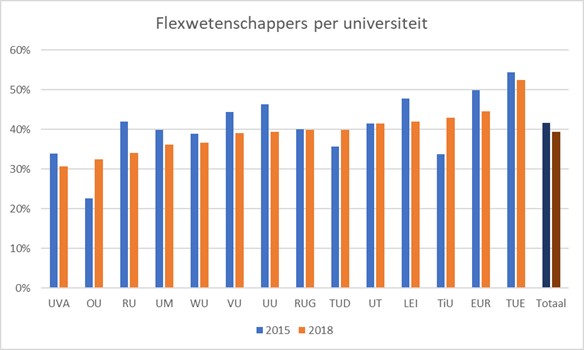TU/e has highest percentage flex academics
A slight upward trend is once again evident in the number of academics gaining permanent employment at universities. Nonetheless, temporary contracts are still their bread and butter, especially in the lower ranks of academia. At the end of last year, TU/e had 52 percent of its academic staff on temporary contracts. This is considerably higher than the national average of 39 percent and so compared to other Dutch universities TU/e is ahead on percentage points.
Professors and associate professors invariably have a permanent contract, but in the ranks below them, temporary contracts are very common. Trade unions have been complaining about this for years and likewise in negotiations on collective labor agreements this is a thorny issue. Only this spring Minister Ingrid van Engelshoven accused the universities of running overly conservative budgets and of not hiring enough permanent employees.
The commotion may have had some effect. Nationally, the proportion of ‘flex academics’ decreased from 42 percent in 2015 to 39 percent in 2018, as revealed by the latest figures from universities' association VSNU. Only Delft, Tilburg and the Open University are bucking the trend: they now have more academics in temporary employment than in 2015. At TU/e the percentage fell over this three-year period from 54 to 52.
Assistant professors have been the chief beneficiaries of this increase in permanent employment over the past few years, although even now one in four (26 percent) still has an expiry date on their contract. In 2015 this was true of 31 percent. In itself this is encouraging, believes spokesperson Marijtje Jongsma of the academic union VAWO, but she quickly points out the sizeable differences between universities. “In Tilburg 61 percent of assistant professors are still in temporary employment, at Erasmus University Rotterdam the figure is 56 percent and in Groningen 43 percent.” Looking at the data of the Business Intelligence Cluster at TU/e, which tabulated the VSNU's figures through to the end of 2017, the percentage of assistant professors on a temporary contract here in Eindhoven at year-end 2017 was forty. A very different picture from TU Delft (1 percent) and UvA (9 percent).
Similarly, the picture varies somewhat in the category ‘other lecturers’ (OWPOW in Dutch jargon): at Utrecht University 82 percent has no permanent contract, followed closely by Erasmus University Rotterdam (75 percent) and Leiden with 74 percent. Nationally, 51 percent of these lecturers now has a temporary contract compared with 56 percent in 2015. At TU/e, according to the data of BI Cluster, at the end of 2017 only 25 percent of 'other lecturers' were in this position, but in the category OWPOZ, which includes postdocs and researchers, 95 percent was employed on a temporary contract.
Imbalance
What most concerns Jongsma is the ever increasing imbalance between the number of students and academics. “According to the VSNU figures, the number of enrolled students rose between 2016 and 2018 by more than 10 percent (from 264,681 to 291,277) while academic staff (excluding doctoral candidates) rose by only 5.3 percent (from 17,660 fte to 18,600 fte).”
She refers to the surveys held by the FNV and VAWO unions among university employees: “Over the past three years these have shown that academic personnel are doing some 20 percent overtime on a permanent basis and are experiencing heavy work pressure. These new figures do not bode well.”



Discussion